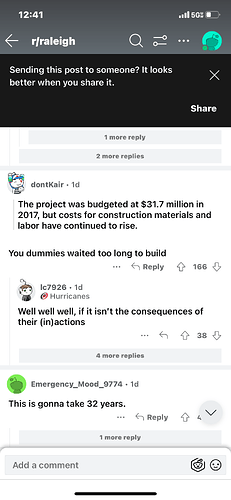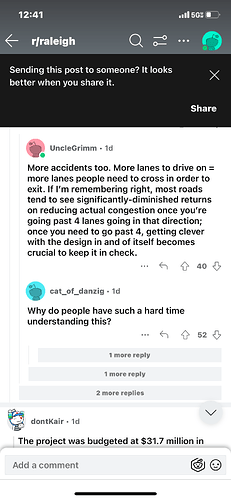That’s better than nothing at least…
Looking forward to the 10 years of studies that will be performed on this new iteration of the project
To their defense, those have already concluded, the city just needs to secure funding and start construction and finish on-time.
Out of curiosity, does anyone here remember/know why the focus of this was on north of Rowan?
It feels like most people’s complaints about traffic in the area is from the ~0.5 mile stretch from Rowan to the Beltline, past North Hills.
I drive Six Forks every day, and yea… between Lynn and Rowan is a major choke point. Sure there is a lot of traffic around the Beltline, but the backups are always to the north. Between Creedmoor and Capital, there just aren’t many roads (Six Forks, Wake Forest/Falls, and Atlantic) that run north south. Six Forks is pretty centrally located between the other two arteries, and it handles a lot of traffic. Sure, I would LOVE to run a BRT from Strickland down Six Forks to Atlantic (and beyond), but with the tremendous growth and the existing problems, something has to be done. Until BRT is proven, and folks will ACTUALLY get out of their cars and take transit (I wish!!), we have to deal with the hand we’ve been dealt. Unfortunately, if that means adding a few lanes, then so be it.
Why is construction not slated to start until 2026? Seems like an unnecessary delay.
Don’t have insider knowledge, but my guess is for funding, property acquisition & finishing design. Stuff takes time.
Yep, the city may not have enough funds for this project with next fiscal year’s transportation improvement plan (TIP) funding.
The MA fiscal year starts in July and ends in June of the following year. If Raleigh has the same timeline, funding may already be pretty drained by future projects (2024 & 2025 construction start dates).
Making the roads wider isn’t going to help get people out of their cars. The problem with the BRT is we don’t have the density around the bus lines. So the goal should be to increase housing density along these lines and not widening the road.
Even McDowell and Dawson Downtown are 3-4 lanes on the road a piece.
Wake Forest Rd is already 3 lanes so there is already another arterial road. It’s expected that roads are going to be busy during peak times. Six Forks is normally good otherwise.
On a different note, as much as I dislike this change, I will say that I would be a lot happier if changes were put in place that would connect the two sides of North Hills both pedestrian/bike wise. I don’t really use Six Forks much and probably never will with the changes.
I’ve seen it back up in that stretch during commuting hours. I think the main question for the tax payers of this city should be: is an average 60 second reduction in trip time per vehicle (insert traffic analysis voodoo numbers) worth $56 million?
No. I drive this stretch almost daily taking my daughter to school. Traffic is definitely heavy, but not a standstill. The lanes are very narrow.
Some wider lanes and good pedestrian / cycling paths would be great. But I just don’t see the need to add an extra lane.
That’s right, keep Lead Mine a secret. Except on my commutes home post-pandemic, looks like the secret may be out.
Sssshhhh… that is MY secret route when I don’t have to take my kidos to Sanderson in the mornings.
I’ll add that we have to understand where that traffic is going. If a BRT line runs along Six Fork to downtown but the traffic isn’t going to downtown, it won’t solve the problem. If the traffic on Six Forks is swinging around the Beltline and heading to Wade and RTP, then BRT isn’t going to improve the situation and removing a lane for it is just going to make traffic worse.
HOWEVER, if traffic on Six Forks IS heading downtown, then BRT could make a difference.
My point is that BRT has to solve a problem by taking cars off the road and putting those folks into a transit solution. If BRT is a “tick the box” activity to “have transit”, it will fail in what it’s intended to do.
And in the case of Newbern, the use case for BRT will organically develop around it. That ain’t happenin’ on Six Forks. What’s done is done and I suspect most of the traffic along Six Forks is from resi north to beltway south and visa-versa, which BRT would just get in the way.
Somewhere midpoint between 540 and 440, Six Forks traffic largely flows in opposite directions during rush hours.
Potentially dumb question, but was there anything that required the Council to act here? Was cancelling the whole project (i.e., leaving Six Forks as is) an option? Just curious.
“Why do people have such a hard time understanding this” → because the concept of induced demand, while valid, coherent, and empirically supported, is also counterintuitive.

